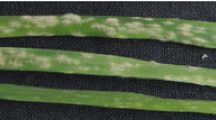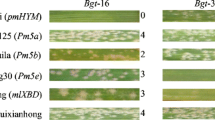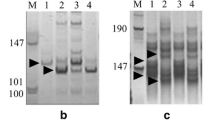Abstract
Powdery mildew caused by Blumeria graminis f. sp. tritici is an important wheat disease in China and other parts of the world. Wild emmer (Triticum turgidum var. dicoccoides) is the immediate progenitor of cultivated tetraploid and hexaploid wheats and thus an important resource for wheat improvement. Wild emmer accession IW2 collected from Mount Hermon, Israel, is highly resistant to powdery mildew at the seedling and adult plant stages. Genetic analysis using an F2 segregating population and F2:3 families, derived from a cross between susceptible durum cultivar Langdon and wild emmer accession IW2, indicated that a single dominant gene was responsible for the resistance of IW2. Bulked segregant and molecular marker analyses detected that six polymorphic SSR, one ISBP, and three EST-STS markers on chromosome 3BL bin 0.63–1.00 were linked to the resistance gene. Allelic variations of resistance-linked EST-STS marker BE489472 revealed that the allele was present only in wild emmer but absent in common wheat. Segregation distortion was observed for the powdery mildew resistance allele and its linked SSR markers with preferential transmission of Langdon alleles over IW2 alleles. The resistance gene was introgressed into common wheat by backcrossing and marker-assisted selection. Since no designated powdery mildew resistance gene has been found on chromosome 3BL, the resistance gene derived from wild emmer accession IW2 appears to be new one and was consequently designated Pm41.



Similar content being viewed by others
References
Bennett FGA (1984) Resistance to powdery mildew in wheat: a review of its use in agriculture and breeding programmes. Plant Pathol 33:279–300
Blanco A, Gadaleta A, Cenci A, Carluccio AV, Abdelbacki AM, Simeone R (2008) Molecular mapping of the novel powdery mildew resistance gene Pm36 introgressed from Triticum turgidum var. dicoccoides in durum wheat. Theor Appl Genet 117:135–142
Bossolini E, Wicker T, Knobel PA, Keller B (2007) Comparison of orthologous loci from small grass genomes Brachypodium and rice: implications for wheat genomics and grass genome annotation. Plant J 49:704–717
Cenci A, D’Ovidio R, Tanzarella OA, Ceoloni C, Porceddu E (1999) Identification of molecular markers linked to Pm13, an Aegilops longissima gene conferring resistance to powdery mildew in wheat. Theor Appl Genet 98:448–454
Ceoloni C, Del Signore G, Pasquini M, Testa A (1988) Transfer of mildew resistance from Triticum longissimum into wheat by ph1 induced homoeologous recombination. In: Miller TE, Koebner RMD (eds) Proc 7th Int Wheat Genet Symp, Cambridge, UK, pp 221–226
Chen P, Qi L, Zhou P, Zhang SZ, Liu DJ (1995) Development and molecular cytogenetic analysis of wheat-H. villosa 6VS/6AL translocation lines specifying resistance to powdery mildew. Theor Appl Genet 91:1125–1128
Chen X, Luo Y, Xia X, Xia L, Chen X, Ren Z, He Z, Jia J (2005) Chromosomal location of powdery mildew resistance gene Pm16 in wheat using SSR marker analysis. Plant Breed 124:225–228
Cistué L, Echávarri B, Battle F, Soriano M, Castillo A, Vallés MP, Romagosa I (2005) Segregation distortion for agronomic traits in doubled haploid lines of barley. Plant Breed 124:546–550
Duan X, Sheng B, Zhou Y, Xiang Q (1998) Monitoring of the virulence population of Erysiphe graminis f. sp. tritici. Acta Phytophylac Sin 25:31–36
Faris JD, Laddomada B, Gill BS (1998) Molecular mapping of segregation distortion loci in Aegilops tauschii. Genetics 149:319–327
Fu D, Uauy C, Distelfeld A, Blechl A, Epstein L, Chen X, Sela H, Fahima T, Dubcovsky J (2009) A kinase-START gene confers temperature-dependent resistance to wheat stripe rust. Science 323:1357–1360
Gerechter-Amitai ZK, van Silfhout CH (1984) Resistance to powdery mildew in wild emmer (Triticum dicoccoides Körn.). Euphytica 33:273–280
Graner A, Jahoor A, Schondelmaier J, Siedler H, Pillen K, Fischbeck G, Wenzel G, Herrmann RG (1991) Construction of an RFLP map of barley. Theor Appl Genet 83:250–256
Hao YF, Liu AF, Wang YH, Feng DS, Gao JR, Li XF, Liu SB, Wang HG (2008) Pm23: a new allele of Pm4 located on chromosome 2AL in wheat. Theor Appl Genet 117:1205–1212
Harushima Y, Kurata N, Yano M, Nagamura Y, Sasaki T, Minobe Y, Nakagahra M (1996) Detection of segregation distortions in an indica–japonica rice cross using a high-resolution molecular map. Theor Appl Genet 92:145–150
Hua W, Liu ZJ, Zhu J, Xie CJ, Yang TM, Zhou YL, Duan XY, Sun QX, Liu ZY (2009) Identification and genetic mapping of pm42, a new recessive wheat powdery mildew resistance gene derived from wild emmer (Triticum turgidum var. dicoccoides). Theor Appl Genet (In press)
Huang XQ, Hsam SLK, Zeller FJ (2000) Chromosomal location of two novel genes for resistance to powdery mildew in Chinese landraces (Triticum aestivum L. em. Thell.). J Genet Breed 54:311–317
Ji XL, Xie CJ, Ni ZF, Yang TM, Nevo E, Fahima T, Liu ZY, Sun QX (2007) Identification and genetic mapping of a powdery mildew resistance gene in wild emmer (Triticum dicoccoides) accession IW72 from Israel. Euphytica 159:385–390
Kumar S, Gill BS, Faris JD (2007) Identification and characterization of segregation distortion loci along chromosome 5B in tetraploid wheat. Mol Genet Gent 278:187–196
Lagudah ES, McFadden H, Singh RP, Huerta-Espino J, Bariana HS, Spielmeyer W (2006) Molecular genetic characterization of the Lr34/Yr18 slow rusting resistance gene region in wheat. Theor Appl Genet 114:21–30
Lee JH, Ma Y, Wako T, Li LC, Kim KY, Park SW, Uchiyama S, Fukui K (2004) Flow karyotypes and chromosomal DNA contents of genus Triticum species and rye (Secale cereale). Chromosom Res 12:93–102
Li GQ, Fang TL, Zhang HT, Xie CJ, Yang ZM, Sun QX, Liu ZY (2009) Identification and SSR mapping of two powdery mildew resistance genes in wild emmer (Triticum dicoccoides) accessions IW3 and IW10. Acta Agron Sin (In press)
Lincoln S, Daly M, Lander E (1992) Constructing genetic maps with Mapmaker/EXP3.0 Whitehead Institute Techn Rep, 3rd edn. Whitehead Institute, Cambridge
Liu RH, Meng JL (2003) MapDraw: a Microsoft Excel macro for drawing genetic linkage maps based on given genetic linkage data. Hereditas (Beijing) 25:317–321
Liu ZY, Sun QX, Ni ZF, Yang TM (1999) Development of SCAR markers linked to the Pm21 gene conferring resistance to powdery mildew in common wheat. Plant Breed 118:215–219
Liu ZY, Sun QX, Ni ZF, Nevo E, Yang TM (2002) Molecular characterization of a novel powdery mildew resistance gene Pm30 in wheat originating from wild emmer. Euphytica 123:21–29
Lu H, Romero-Severson J, Bernardo R (2002) Chromosomal regions associated with segregation distortion in maize. Theor Appl Genet 105:622–628
Luig NH (1964) Heterogeneity in segregation data from wheat crosses. Nature 204:260–261
McIntosh RA, Yamazaki Y, Dubcovsky J, Rogers J, Morris C, Somers DJ, Appels R, Devos KM (2008) Catalogue of gene symbols for wheat. In: Appels R, Eastwood R, Lagudah E, Langridge P, Mackay M, McIntyre L, Sharp P (eds) Proc 11th Int Wheat Genet Symp, Sydney University Press, Sydney, Australia
Michelmore RW, Paran I, Kesseli VR (1991) Identification of markers closely linked to disease-resistance genes by bulked segregant analysis: a rapid method to detect markers in specific genomic regions by using segregating populations. Proc Natl Acad Sci USA 88:9828–9832
Mohler V, Zeller FJ, Wenzel G, Hsam SLK (2005) Chromosomal location of genes for resistance to powdery mildew in common wheat (Triticum aestivum L. em Thell). 9. Gene MlZec1 from the Triticum dicoccoides-derived wheat line Zecoi-1. Euphytica 142:161–167
Moseman JG, Nevo E, El-Morshidy MA, Zohary D (1984) Resistance of Triticum dicoccoides collected in Israel to infection with Erysiphe graminis tritici. Euphytica 33:41–47
Munkvold JD, Greene RA, Bermudez-Kandianis CE, La Rota CM, Edwards H, Sorrells SF, Dake T, Benscher D, Kantety R, Linkiewicz AM, Dubcovsky J, Akhunov ED, Dvorák J, Miftahudin, Gustafson JP, Pathan MS, Nguyen HT, Matthews DE, Chao S, Lazo GR, Hummel DD, Anderson OD, Anderson JA, Gonzalez-Hernandez JL, Peng JH, Lapitan N, Qi LL, Echalier B, Gill BS, Hossain KG, Kalavacharla V, Kianian SF, Sandhu D, Erayman M, Gill KS, McGuire PE, Qualset CO, Sorrells ME (2004) Group 3 chromosome bin maps of wheat and their relationship to rice chromosome 1. Genetics 168:639–650
Nevo E (1995) Genetic resources of wild emmer, Triticum dicoccoides, for wheat improvement: news and views. In Li ZS, Xin ZY (eds) Proc 8th Int Wheat Genet Symp, China Agricultural Scientech Press, Beijing, pp 79–87
Nevo E, Beiles A (1989) Genetic diversity of wild emmer wheat in Israel and Turkey: structure, evolution and application in breeding. Theor Appl Genet 77:421–455
Nevo E, Korol AB, Beiles A, Fahima T (2002) Evolution of wild emmer and wheat improvement: population genetics, genetic resources, and genome organization of wheat’s progenitor. Triticum dicoccoides. Springer, Berlin/Heidelberg
Nyquist WE (1962) Differential fertilization in the inheritance of stem rust resistance in hybrids involving a common wheat strain derived from Triticum timopheevi. Genetics 47:1109–1124
Paux E, Roger D, Badaeva E, Gay G, Bernard M, Sourdille P, Feuillet C (2006) Characterizing the composition and evolution of homoeologous genomes in hexaploid wheat through BAC-end sequencing on chromosome 3B. Plant J 48:463–474
Paux E, Sourdille P, Salse J, Saintenac C, Choulet F, Leroy P, Korol A, Michalak M, Kianian S, Spielmeyer W, Lagudah E, Somers D, Kilian A, Alaux M, Vautrin S, Bergès H, Eversole K, Appels R, Safar J, Simkova H, Dolezel J, Bernard M, Feuillet C (2008) A physical map of the 1-gigabase bread wheat chromosome 3B. Science 322:101–104
Peng J, Korol AB, Fahima T, Röder M, Ronin YI, Li YC, Nevo E (2000) Molecular genetic maps in wild emmer wheat, Triticum dicoccoides: genome-wide coverage, massive negative interference, and putative quasi-linkage. Genome Res 10:1509–1531
Prins R, Marais GF (1999) A genetic study of the gametocidal effect of the Lr19 translocation of common wheat. S Afr J Plant Soil 16:10–14
Qiu YC, Zhang SS (2004) Researches on powdery mildew resistant genes and their molecular markers in wheat. J Triticeae Crops 24:127–132
Reader SM, Miller TE (1991) The introduction into bread wheat of a major gene for resistance to powdery mildew from wild emmer wheat. Euphytica 53:57–60
Röder MS, Korzun V, Wendehake K, Plaschke J, Tixier MH, Leroy P, Ganal MW (1998) A microsatellite map of wheat. Genetics 149:2007–2023
Rong JK, Millet E, Manisterski J, Feldman M (2000) A new powdery mildew resistance gene: introgression from wild emmer into common wheat and RFLP-based mapping. Euphytica 115:121–126
Sears ER, Loegering WQ (1961) A pollen-killing gene in wheat. Genetics 46:897
Sharp PG, Kreis M, Shewry PR, Gale MD (1988) Location of b-amylase sequence in wheat and its relatives. Theor Appl Genet 75:289–290
Somers DJ, Isaac P, Edwards K (2004) A high-density microsatellite consensus map for bread wheat (Triticum aestivum L.). Theor Appl Genet 109:1105–1114
Sorrells ME, La Rota M, Bermudez-Kandianis CE, Greene RA, Kantety R, Munkvold JD, Miftahudin, Mahmoud A, Ma X, Gustafson PJ, Qi LL, Echalier B, Gill BS, Matthews DE, Lazo GR, Chao S, Anderson OD, Edwards H, Linkiewicz AM, Dubcovsky J, Akhunov ED, Dvorak J, Zhang D, Nguyen HT, Peng J, Lapitan NL, Gonzalez-Hernandez JL, Anderson JA, Hossain K, Kalavacharla V, Kianian SF, Choi DW, Close TJ, Dilbirligi M, Gill KS, Steber C, Walker-Simmons MK, McGuire PE, Qualset CO (2003) Comparative DNA sequence analysis of wheat and rice genomes. Genome Res 13:1818–1827
Sourdille P, Singh S, Cadalen T, Brown-Guedira GL, Gay G, Qi L, Gill BS, Dufour P, Murigneux A, Bernard M (2004) Microsatellite-based deletion bin system for the establishment of genetic–physical map relationships in wheat (Triticum aestivum L.). Funct Integr Genomics 4:12–25
Tanksley SD, Ganal MW, Martin GB (1995) Chromosome landing: a paradigm for map-based cloning in plants with large genomes. Trends Genet 11:63–68
Turner A, Beales J, Faure S, Dunford RP, Laurie DA (2005) The pseudo-response regulator Ppd-H1 provides adaptation to photoperiod in barley. Science 310:1031–1034
Uauy C, Distelfeld A, Fahima T, Blechl A, Dubcovsky J (2006) A NAC Gene regulating senescence improves grain protein, zinc, and iron content in wheat. Science 314:1298–1301
Wendel JF, Edwards MD, Stuber CW (1987) Evidence for multilocus genetic control of preferential fertilization in maize. Heredity 58:297–302
Xie CJ, Sun QX, Yang ZM (2003) Resistance of wild emmers from Israel to wheat rusts and powdery mildew at seedling stage. J Triticeae Crops 23:39–42
Xu Y, Zhu L, Xiao J, Huang N, McCouch SR (1997) Chromosomal regions associated with segregation distortion of molecular markers in F2, backcross, doubled haploid, and recombinant inbred populations of rice (Oryza sativa L.). Mol Gen Genet 253:535–545
Yahiaoui N, Srichumpa P, Dudler R, Keller B (2004) Genome analysis at different ploidy levels allows cloning of the powdery mildew resistance gene Pm3b from hexaploid wheat. Plant J 37:528–538
Yan L, Loukoianov A, Tranquilli G, Helguera M, Fahima T, Dubcovsky J (2003) Positional cloning of the wheat vernalization gene VRN1. Proc Natl Acad Sci USA 100:6263–6268
Zhang HB, Dvorák J (1990) Characterization and distribution of an interspersed repeated nucleotide sequence from Lophopyrum elongatum and mapping of a segregation distortion factor with it. Genome 33:927–936
Zhuang QS (2003) Chinese wheat improvement and pedigree analysis. China Agriculture Press, Beijing, pp 469–487
Acknowledgments
The Chinese Spring aneulpoid and deletion lines used in this study were originally provided by Drs. WJ Raupp and BS Gill of Wheat Genetics Resource Centre, Kansas State University, USA. The authors are grateful to Dr. R McIntosh of University of Sydney, Australia, for his improvement of the manuscript. This work was financially supported by the National Fund for Distinguished Young Scholars (30425039), National Natural Science Foundation of China (30571151, 30771341), Beijing Natural Science Foundation (6061003), and the State High Tech Programs (2006AA100102, 2006AA10Z1E9, 2006AA10Z1C4, 2006AA10A104, and 2006BAD01A02), State Transgenic Project (2008ZX08009-002), the Program of Introducing Talents of Discipline to Universities (111-2-03), and the Program for Changjiang Scholars and Innovative Research Teams in Universities.
Author information
Authors and Affiliations
Corresponding authors
Additional information
Communicated by B. Keller.
Electronic supplementary material
Below is the link to the electronic supplementary material.
Rights and permissions
About this article
Cite this article
Li, G., Fang, T., Zhang, H. et al. Molecular identification of a new powdery mildew resistance gene Pm41 on chromosome 3BL derived from wild emmer (Triticum turgidum var. dicoccoides). Theor Appl Genet 119, 531–539 (2009). https://doi.org/10.1007/s00122-009-1061-y
Received:
Accepted:
Published:
Issue Date:
DOI: https://doi.org/10.1007/s00122-009-1061-y




